Discover Florida Nature
It's time to explore the natural Florida


|
|
|
|
|
Emersed plants are plants that grow out of the water (or during
low-water times, in exposed sediments). They are rooted to the bottom,
but their stems, leaves and flowers are above the water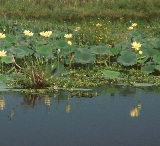 American
Lotus (Nelumbo lutea)- The grandiose American lotus is an
emersed native. Its leaves may be emersed above the water or floating on
it. The plant can be found in muddy, shallow waters such as lake
margins, or in water as deep as six feet. Two species of Nelumbo
occur in Florida. American lotus can be found in California and
throughout the eastern half of US and Canada. This large plant is very
easy to identify. Its flowers are extremely large, typically six inches
wide. Flowers are luminescent yellow with many petals and stamens.
American lotus leaves are circular, and do not have a "cut", as do water
lily leaves. The lotus leaf is on a long, stiff stalk that is connected
to the leaf at the very center of the leaf, umbrella-like. American
lotus seedpods are sold as ornamental items American
Lotus (Nelumbo lutea)- The grandiose American lotus is an
emersed native. Its leaves may be emersed above the water or floating on
it. The plant can be found in muddy, shallow waters such as lake
margins, or in water as deep as six feet. Two species of Nelumbo
occur in Florida. American lotus can be found in California and
throughout the eastern half of US and Canada. This large plant is very
easy to identify. Its flowers are extremely large, typically six inches
wide. Flowers are luminescent yellow with many petals and stamens.
American lotus leaves are circular, and do not have a "cut", as do water
lily leaves. The lotus leaf is on a long, stiff stalk that is connected
to the leaf at the very center of the leaf, umbrella-like. American
lotus seedpods are sold as ornamental items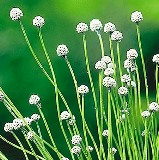 Bog
Buttons (Lachnocaulon)- Because of their many white-to-gray
button-like heads, the smallish bog buttons are easily discovered when
searching for them along wet roadsides. There are five species of
Lachnocaulon in Florida. Bog buttons are located throughout the southern
and southwestern parts of the US, including Florida. Bog Buttons have
dark thin branched stems. It's leaf blades are grass-like and arranged
in spiral clusters with narrow, tapering, and growing to two inches in
length. Bog Buttons have inflorescences button-like heads, that are
white to gray, at the tips of long stems, comprised of many tiny,
densely-clustered whitish-to-grayish flowers. Bog
Buttons (Lachnocaulon)- Because of their many white-to-gray
button-like heads, the smallish bog buttons are easily discovered when
searching for them along wet roadsides. There are five species of
Lachnocaulon in Florida. Bog buttons are located throughout the southern
and southwestern parts of the US, including Florida. Bog Buttons have
dark thin branched stems. It's leaf blades are grass-like and arranged
in spiral clusters with narrow, tapering, and growing to two inches in
length. Bog Buttons have inflorescences button-like heads, that are
white to gray, at the tips of long stems, comprised of many tiny,
densely-clustered whitish-to-grayish flowers. 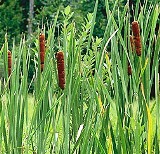 Cat-tails
(Typha)- Most Typha species in Florida are native and they often grow to
cover large areas of wetlands, lakes and rivers. They are among the most
common of all aquatic and wetland plants anywhere. Cat-tails get their
name from their brown cylindrical flower spikes which can be more than
one foot long. Cat-tails provide protective cover and nesting areas for
animals and birds. Cat Tails occur almost always under natural
conditions in wetlands. Cat-tails have rhizomes extensive, fleshy; stems
that can grow to nine feet. They have tall leaf blades that are
strap-like, stiff, and rounded on the back. Cat tail leaves spiral on
the top half, and are sheathed together at the base to appear
"flattened". Cat tails are very densely packed with tiny flowers; male
flowers in the top clusterand female flowers in the bottom cluster. Cat-tails
(Typha)- Most Typha species in Florida are native and they often grow to
cover large areas of wetlands, lakes and rivers. They are among the most
common of all aquatic and wetland plants anywhere. Cat-tails get their
name from their brown cylindrical flower spikes which can be more than
one foot long. Cat-tails provide protective cover and nesting areas for
animals and birds. Cat Tails occur almost always under natural
conditions in wetlands. Cat-tails have rhizomes extensive, fleshy; stems
that can grow to nine feet. They have tall leaf blades that are
strap-like, stiff, and rounded on the back. Cat tail leaves spiral on
the top half, and are sheathed together at the base to appear
"flattened". Cat tails are very densely packed with tiny flowers; male
flowers in the top clusterand female flowers in the bottom cluster.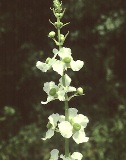 Duck
Potato (Sagittaria lancifolia)- Duck potato is an emersed
plant. It's large leaves and conspicuous flowers make it easy to find in
the wild. It grows commonly in swamps, ditches, lakes, and stream
margins. Duck potato gets its name from its potato-like, underground
corms that sometimes form. Duck potato has large, firm, lance-shaped
leaves, which are typically four inches wide and up to two feet long.
The leaf base tapers to the stem. The leaves grow as a fan-like rosette
from underground rhizomes. Duck potato flowers are typical sagittaria
flowers: showy and white, with three petals. Flowers are extended on
thick stalks that are often a foot or more above the leaves. Duck
Potato (Sagittaria lancifolia)- Duck potato is an emersed
plant. It's large leaves and conspicuous flowers make it easy to find in
the wild. It grows commonly in swamps, ditches, lakes, and stream
margins. Duck potato gets its name from its potato-like, underground
corms that sometimes form. Duck potato has large, firm, lance-shaped
leaves, which are typically four inches wide and up to two feet long.
The leaf base tapers to the stem. The leaves grow as a fan-like rosette
from underground rhizomes. Duck potato flowers are typical sagittaria
flowers: showy and white, with three petals. Flowers are extended on
thick stalks that are often a foot or more above the leaves.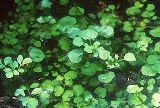 Florida
Water Cress (Rorippa floridana)- Florida Water Cress is found
only in Florida. It is one of five water cresses in the state and one of
about 30 in the U.S. and Canada. Florida water cress is frequently found
growing in spring runs and blackwater swamps from the peninsula to the
central panhandle to north central Florida. Florida water cress blooms
in the spring. Watercress is a perennial plant grown for the pungent
leaves and young stems which are widely used for garnishing and in
salads. The smooth compound leaves have three to a dozen nearly round
one inch-wide leaflets. Leaves and stems are partially submerged during
growth. Florida
Water Cress (Rorippa floridana)- Florida Water Cress is found
only in Florida. It is one of five water cresses in the state and one of
about 30 in the U.S. and Canada. Florida water cress is frequently found
growing in spring runs and blackwater swamps from the peninsula to the
central panhandle to north central Florida. Florida water cress blooms
in the spring. Watercress is a perennial plant grown for the pungent
leaves and young stems which are widely used for garnishing and in
salads. The smooth compound leaves have three to a dozen nearly round
one inch-wide leaflets. Leaves and stems are partially submerged during
growth.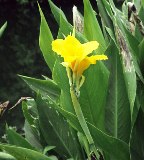 Golden
Canna (Canna flaccida)- Golden Canna is a showy, emersed native
plant which typically grows to four feet tall. Golden canna is
frequently found in small stands at the edges of marshes, swamps, ponds
and lakes from the peninsula west to the central panhandle of Florida.
It has been hybridized and may also be found in household gardens. There
are two species of Canna in Florida. Golden Canna flowers are showy
yellow, while Hybrid Canna has flowers tinged with orange and red. The
three-inch-long flowers grow in clusters at the tops of long stalks.
Golden canna leaves attach in a spiral along the stem. The leaf shape is
oblong to elliptic, with tapering bases and pointed tips. Leaves may be
six inches wide and two feet long. The fruit is a large three-part
capsule that is rough to the touch. Golden
Canna (Canna flaccida)- Golden Canna is a showy, emersed native
plant which typically grows to four feet tall. Golden canna is
frequently found in small stands at the edges of marshes, swamps, ponds
and lakes from the peninsula west to the central panhandle of Florida.
It has been hybridized and may also be found in household gardens. There
are two species of Canna in Florida. Golden Canna flowers are showy
yellow, while Hybrid Canna has flowers tinged with orange and red. The
three-inch-long flowers grow in clusters at the tops of long stalks.
Golden canna leaves attach in a spiral along the stem. The leaf shape is
oblong to elliptic, with tapering bases and pointed tips. Leaves may be
six inches wide and two feet long. The fruit is a large three-part
capsule that is rough to the touch. Lemon
Bacopa (Bacopa caroliniana) -Lemon bacopa is an emersed plant.
This small sprawling herb is common in fresh and brackish waters. At
least three species of bacopa are native to Florida. This species, lemon
bacopa, is distinguished by its blue flowers, a hairy upper stem, and by
the lemony scent of its crushed leaves. Bacopa leaves are succulent and
relatively thick. Its leaves are only 1/8 inch wide and 5/8 inch long.
Leaves are almost round, and are arranged oppositely on the stem.
Flowers are small and blue, with 4 or 5 petals. Lemon
Bacopa (Bacopa caroliniana) -Lemon bacopa is an emersed plant.
This small sprawling herb is common in fresh and brackish waters. At
least three species of bacopa are native to Florida. This species, lemon
bacopa, is distinguished by its blue flowers, a hairy upper stem, and by
the lemony scent of its crushed leaves. Bacopa leaves are succulent and
relatively thick. Its leaves are only 1/8 inch wide and 5/8 inch long.
Leaves are almost round, and are arranged oppositely on the stem.
Flowers are small and blue, with 4 or 5 petals.
|
|
|
Advertise | Privacy Statement | Dog Encyclopedia | Video |Contact | Alaska Nature |
|